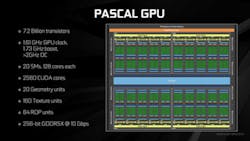Electronics History: NVIDIA’s Pascal Architecture and the GTX 1080
This article is part of the Electronics History series: The Graphics Chip Chronicles.
The GeForce GTX 1080 was a high-end graphics card developed by NVIDIA. One of the first GPUs based on the company’s Pascal architecture, the GPU ushered in significant improvements in performance and efficiency over its predecessors. The GTX 1080, launched in May 2016, was based on the 16-nm FinFET process from TSMC. It became a hit with gamers and professionals alike.
NVIDIA introduced the GTX brand with the GeForce GTX 200 series launch in 2008. The first GPUs in this series were the GeForce GTX 260 and GeForce GTX 280, which were based on the Tesla architecture. This marked the beginning of the company’s use of the "GTX" designation for high-performance gaming and enthusiast-grade graphics cards.
NVIDIA announced the Pascal architecture at the Game Developers Conference (GDC) in March 2016. The GTX 1080 made the most of it, giving consumers access to the performance required for 1080p, 1440p, and gaming at even higher resolutions. The GP104 GPU at its heart was very energy-efficient due to being based on the 16-nm node from TSMC. As a result, it offered high performance with lower power consumption, making it suitable for gaming PCs without requiring excessive power-supply upgrades.
Virtual reality (VR) was at the peak of its popularity at the time, bolstered by Meta’s Oculus deal in 2014. NVIDIA emphasized that the GTX line was future-proofed and VR-ready, likely contributing to the add-in board’s (AIB) popularity, even though very few consumers owned or planned to buy a VR headset.
The AIB featured a 256-bit memory bus for the 8 GB of GDDR5X memory, giving it faster data rates compared to the GDDR5 memory used in earlier models and by the competition. That enhanced the GPU’s performance for gaming and professional workloads.
From Gaming to Crypto
While primarily targeted at gamers, the GTX 1080 was also a hit with creative professionals and researchers due to the 25% increase in shader cores to 2,560 cores, up from 2,048 in the predecessor GTX 980. NVIDIA started using the term “CUDA cores” to market the shader cores in its GPUs with the release of the GeForce 8 series in 2006. That coincided with the introduction of the CUDA (Compute Unified Device Architecture) programming platform. The GTX 1080, with its CUDA cores, had the ability to handle demanding computational tasks as well.
The use of GPUs for mining cryptocurrencies started as early as 2010 with Bitcoin. However, one of the first cryptocurrencies to take full advantage of the parallel-processing capability of GPUs was Ethereum, which launched in mid-2015.
The GTX 1080, with its new highly efficient and massive processing power, came to market when four forces arrived at once—new highly intricate video games demanding as much GPU power as possible; the rollout of higher resolution screens; the introduction of VR; and the demand for more processing power from the crypto crowd.
These factors combined made the GTX 1080 a standout product for gamers, professionals, and everyone in between, solidifying NVIDIA’s place in the high-performance GPU market and paving the road for the introduction of AI.
The Power of NVIDIA’s Pascal GPU Architecture
TSMC’s 16-nm FinFET process proved to be highly efficient, so the yields increased. As with any process for semiconductor fabrication, performance grades are distributed across a wafer. The 16-nm node yielded an unusual percentage of above-spec parts for NVIDIA. As a result, NVIDIA released the GTX 1080 Ti in March 2017 with 3,584 CUDA cores to the market—40% more, providing a 35% performance boost over the GTX 1080. The GTX 1080 series was the goose laying golden eggs.
However, the GTX 1060 released half a year before the GTX 1080 turned out to be the company’s most commercially successful graphics product based on the Pascal architecture. It, too, was a beneficiary of the TSMC process, made from chips that didn’t quite meet the specs for the formidable 1080.
Initially released with 1,280 cores and mounted on an AIB with 6 GB of GDDR5 memory, the company also rolled out a graphics card with 1,152 cores and 3 GB of DRAM, resulting from binning of parts not meeting the specification for the bigger 1060.
The success of the GPU, aside from the serendipity of the TSMC process, stemmed from its combination of affordability, power efficiency, and performance, specifically for 1080p gaming, which made it very popular among gamers. At the time, around 90% of gamers had a not-too-old 1080p display. While the GTX 1080 brought more processing property and memory, albeit at a higher price, its ability to drive VR and higher-resolution screens weren’t the main selling points for economy-driven gamers.
Conversely, the GTX 1060 targeted the mid-range market, appealing to a wider range of consumers. The GPU came with high performance for the price, making it suitable for an array of games at 1080p, and it could even run several games at 1440p. The GTX 1060 was also a power miser, leveraging the energy-efficient Pascal architecture, reducing the need for high-end power supplies. This presented another cost savings for economics-bound gamers.
The combination of price, performance, and power efficiency transformed the GTX 1060 into one of NVIDIA's top-selling GPUs, beating out the widespread adoption of even the GTX 750 (based on NVIDIA’s Maxwell architecture) and the GTX 970. The AIB remained relevant for years due to regular GPU driver updates and robust performance.


